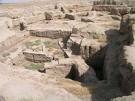 Mari was an ancient city in Syria situated on the site of Tell Hariri, 11 kilometers north-west of the modern locality of Abu Kamal on the western bank of Euphrates river, some 120 km southeast of Deir ez-Zor, Syria. It is thought to have been inhabited since the 5th millennium BC, although it flourished from 2900 BC until 1759 BC, when it was sacked by Hammurabi
Mari was an ancient city in Syria situated on the site of Tell Hariri, 11 kilometers north-west of the modern locality of Abu Kamal on the western bank of Euphrates river, some 120 km southeast of Deir ez-Zor, Syria. It is thought to have been inhabited since the 5th millennium BC, although it flourished from 2900 BC until 1759 BC, when it was sacked by Hammurabi
Intendant Ebih-Il, found in the temple of Ishtar at Mari, Archaic Dynasties (ca. 2400 BC), Louvre Museum
The citizens of Mari were well known for elaborate hair styles and dress, and were considered to be part of Mesopotamian culture, despite being more than 150 miles upriver of Babylon. It is theorized by some that Mari functioned as a trading outpost for southern Mesopotamia.
 The inhabitants of Mari worshiped a vast array of Sumerians gods and goddesses. Dagan, the deity of storms, had an entire temple dedicated to him, as did Ishtar, the goddess of fertility, and Shamash, the Sun god. Shamash was believed to be all-knowing and all-seeing, and in many seals he is seen standing between two large doors. According to the legend of Gilgamesh, these doors are between Mount Mashu, and are the eastern doors to heaven. Through Mari's extensive trade network, Sumerian gods and goddesses were taken to non-Sumerian cities such as Ebla and Ugarit and incorporated into their native religions.
The inhabitants of Mari worshiped a vast array of Sumerians gods and goddesses. Dagan, the deity of storms, had an entire temple dedicated to him, as did Ishtar, the goddess of fertility, and Shamash, the Sun god. Shamash was believed to be all-knowing and all-seeing, and in many seals he is seen standing between two large doors. According to the legend of Gilgamesh, these doors are between Mount Mashu, and are the eastern doors to heaven. Through Mari's extensive trade network, Sumerian gods and goddesses were taken to non-Sumerian cities such as Ebla and Ugarit and incorporated into their native religions.


